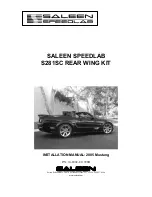
23
CHAPTER 2. SAFETY REQUIREMENTS AND WARNINGS
SAFETY REQUIREMENTS<B}
1.
When using the vehicle, it is necessary to observe the road traffic regulations and safety requirements strictly, as
well as keep the vehicle in a technically sound condition when timely performing its maintenance and eliminating possible
malfunctions so as not to cause harm to yourself and others.
2.
The driver is liable for passengers. Therefore, he is obliged to control passenger compliance with safety
regulations. Be especially careful if there are children in the vehicle. Do not leave children in the vehicle unattended.
3.
It is forbidden to turn off the ignition and remove the key from the ignition switch when the vehicle is moving.
Stopping the engine will reduce the brake performance, and with the ignition key removed, the steering shaft is blocked by
an anti-theft device, and the vehicle becomes uncontrollable.
4.
When leaving the vehicle, do not leave the door and ignition keys in it.
5.
Before opening the door, make sure that it does not interfere with other road users.
Before closing the door, make sure that nothing is not pinched by it.
Never drive the vehicle with any door or hinged tailboard open.
Check that the body door and side locks are working properly and securely locked before you drive the vehicle.
6.
Seat belts are an effective mean of the vehicle driver and passenger protection from the serious consequences of
road accidents.
It is mandatory to use seat belts!
7.
Worn and damaged tires, insufficient or excessive air pressure in them, deformed wheels or weakening of wheel
attachment can cause an accident.
8. In case of brake system or steering malfunction, further driving or towing the vehicle with the use of a flexible
towing coupler is prohibited. In this case, tow the vehicle with the use of partial loading or breakdown truck.
9. Disassembly of shock absorbers is strictly prohibited.
10. It is forbidden to warm up the engine in a closed room that does not have good ventilation, in order to avoid
carbon monoxide poisoning.
11. Do not use an open flame to heat the vehicle assemblies.
12. Keep the engine clean (engine oil on the surfaces of the engine, especially in the crankcase can result in a fire).
13. Ensure that the fuel tank caps are tightly sealed and there are no leaks from the fuel lines.
14. The operating temperature of the catalyst is 400-
800 ° C. It is not allowed to operate the vehicle without catalyst
protective screens. After driving on tall grass, be sure to inspect the vehicle. Remove grass or other accumulated foreign
objects from parts located in a close proximity to the exhaust system to prevent possible combustion.
15. When working with a low-freezing fluid, gasoline and brake fluid, observe the following rules:
- avoid any operations in the course of which these liquids or their vapors can get into the oral cavity;
- wash off the liquid on your skin immediately with warm water and soap;
- do not allow it to be spilled in a vehicle or indoors. Rinse the splashed area with water and ventilate;
-
dry clothes contaminated with liquid outside before washing;
- moisten with kerosene the gasoline sludge during scraping to prevent poisonous particles of sludge from entering
the respiratory system;
- when working with fuel, comply with fire safety regulations.
16. After stopping the vehicle, engage the parking brake.
17. Take extra care when working with electrolyte.
To prevent poisoning and chemical burns, observe the following rules:
- strictly comply with safety requirements set forth in the accumulator battery manual;
- do not allow ingress of electrolyte or its vapors into the oral cavity, respiratory organs or eyes, this is extremely
dangerous;
- avoid any operations, as a result of which electrolyte can get onto the skin. If this happens, gently wipe the
electrolyte with cotton wool and immediately wash the remaining traces on the skin with 5% ammonia or sodium
carbonate solution;
-
collect spilled electrolyte with a special rubber bulb or areometer, rinse with water, ventilate the room;
- for charging the battery remove it from the vehicle and unscrew the filler plugs;
- battery shall be charged in a well ventilated room. Accumulation of electrolyte vapors is dangerous to health and
explosive.
18. Do not wash the vehicle with the engine running.
19. An improperly installed jack can cause serious injury or damage to the vehicle. It is strictly forbidden to carry
out work under the vehicle supported by jack.
20. It is forbidden on steep slopes:
- to move with the gearbox and transfer case gears off;
- to turn off the engine due to loss of braking capacity.
21. Follow these safety guidelines when working with the winch:
- make sure that the winch rope is properly secured to the front bumper before starting work;
-
when cable is unwound, it is not allowed to leave less than three turns of cable on the drum;
Содержание UAZ-220695
Страница 10: ...10 Fig 1 7 Outline averaged dimensions of the UAZ 390995 with gross weight dimensions are given for reference ...
Страница 14: ...14 Fig 1 11 Outline averaged dimensions of the UAZ 330365 with gross weight dimensions are given for reference ...
Страница 15: ...15 Fig 1 12 Outline averaged dimensions of the UAZ 390945 with gross weight dimensions are given for reference ...
Страница 88: ...88 Annex 5 85 UAZ CONNECT TELEMATICS SERVICES 85 ...
Страница 89: ... Intentionally Left Blank ...
















































